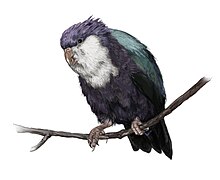| Conquered lorikeet Temporal range: Late Holocene | |
|---|---|

| |
| Hypothetical restoration based on fossils and related species; the colouration is speculative. | |
| Conservation status | |
| Extinct | |
| Scientific classification | |
| Domain: | Eukaryota |
| Kingdom: | Animalia |
| Phylum: | Chordata |
| Class: | Aves |
| Order: | Psittaciformes |
| Family: | Psittaculidae |
| Genus: | Vini |
| Species: | †V. vidivici |
| Binomial name | |
| †Vini vidivici Steadman and Zarriello, 1987 | |
The conquered lorikeet (Vini vidivici) is a species of parrot that became extinct 700–1300 years ago. It lived in islands of Polynesia. David Steadman and Marie Zarriello wrote its species description in 1987.
It was discovered in the oldest archaeological layer of 1000 AD and not recorded after 1200 AD.
Description
It was a large species; the only larger species in Vini was V. sinotoi.
Distribution
Specimens have been found on Hiva Oa, Nuku Hiva, Ua Huka, and Tahuata (Marquesas Islands); Mangaia (Cook Islands); and Huahine (Society Islands).
Etymology
The binomial name is wordplay alluding to "veni, vidi, vici." The authors wrote in the original description:
The meaning, "I came, I saw, I conquered," may be projected into the prehistoric situation in the Marquesas and elsewhere in Polynesia, where people came to an island, saw the native parrots, and then conquered them, leaving behind only the bones.
The generic name in fact does not come from Latin; René Lesson chose Vini as the name for the genus since vini is the Tahitian word for a local bird.
References
- ^ Steadman, David W.; Zarriello, Marie C. (1987). "Two new species of parrots (Aves: Psittacidae) from archeological sites in the Marquesas Islands". Proceedings of the Biological Society of Washington. 100: 523.
- McCormack, Gerald (2007). "Conquered Lorikeet". Cook Islands Biodiversity Database, Version 2007.2. Rarotonga: Cook Islands Natural Heritage Trust.
- Steadman, David W.; Rolett, Barry (1996). "A Chronostratigraphic Analysis of Landbird Extinction on Tahuata, Marquesas Islands". Journal of Archaeological Science. 23 (1): 81–94. Bibcode:1996JArSc..23...81S. doi:10.1006/jasc.1996.0007.
- Steadman, David W.; Kirch, Patrick V. (1990). "Prehistoric extinction of birds on Mangaia, Cook Islands, Polynesia". Proceedings of the National Academy of Sciences. 87 (24): 9605–9609. Bibcode:1990PNAS...87.9605S. doi:10.1073/pnas.87.24.9605. JSTOR 2356461. PMC 55221. PMID 11607131.
- Steadman, David W.; Pahlavan, Dominique S. (1992). "Extinction and biogeography of birds on Huahine, Society Islands, French Polynesia". Geoarchaeology. 7 (5): 449–483. Bibcode:1992Gearc...7..449S. doi:10.1002/gea.3340070503.
- Lesson, R.-P. (1833). "La vini écarlate". Illustrations de zoologie. Paris: Arthus Bertrand. Planche XXVIII.
- "Vini". A Tahitian and English Dictionary. Tahiti: London Missionary Society's Press. 1851. p. 314.
- Wahlroos, Sven (2002). "Vini". English-Tahitian Tahitian-English Dictionary. Honolulu: Māʻohi Heritage Press. p. 684.
| Lories and lorikeets (Tribe: Loriini) | |
|---|---|
| Genus | Species (taxonomy note: * indicates taxa that may classified as a subspecies of the rainbow lorikeet or a separate species) (extinctions: † indicates a species confirmed to be extinct, ₴ indicates evidence only from sub-fossils) |
| Chalcopsitta | |
| Eos | |
| Pseudeos | |
| Trichoglossus | |
| Saudareos | |
| Psitteuteles | |
| Glossoptilus | |
| Lorius | |
| Vini |
|
| Glossopsitta | |
| Parvipsitta | |
| Charmosyna | |
| Charminetta | |
| Hypocharmosyna | |
| Charmosynopsis | |
| Synorhacma | |
| Charmosynoides | |
| Neopsittacus | |
| Taxon identifiers | |
|---|---|
| Vini vidivici | |